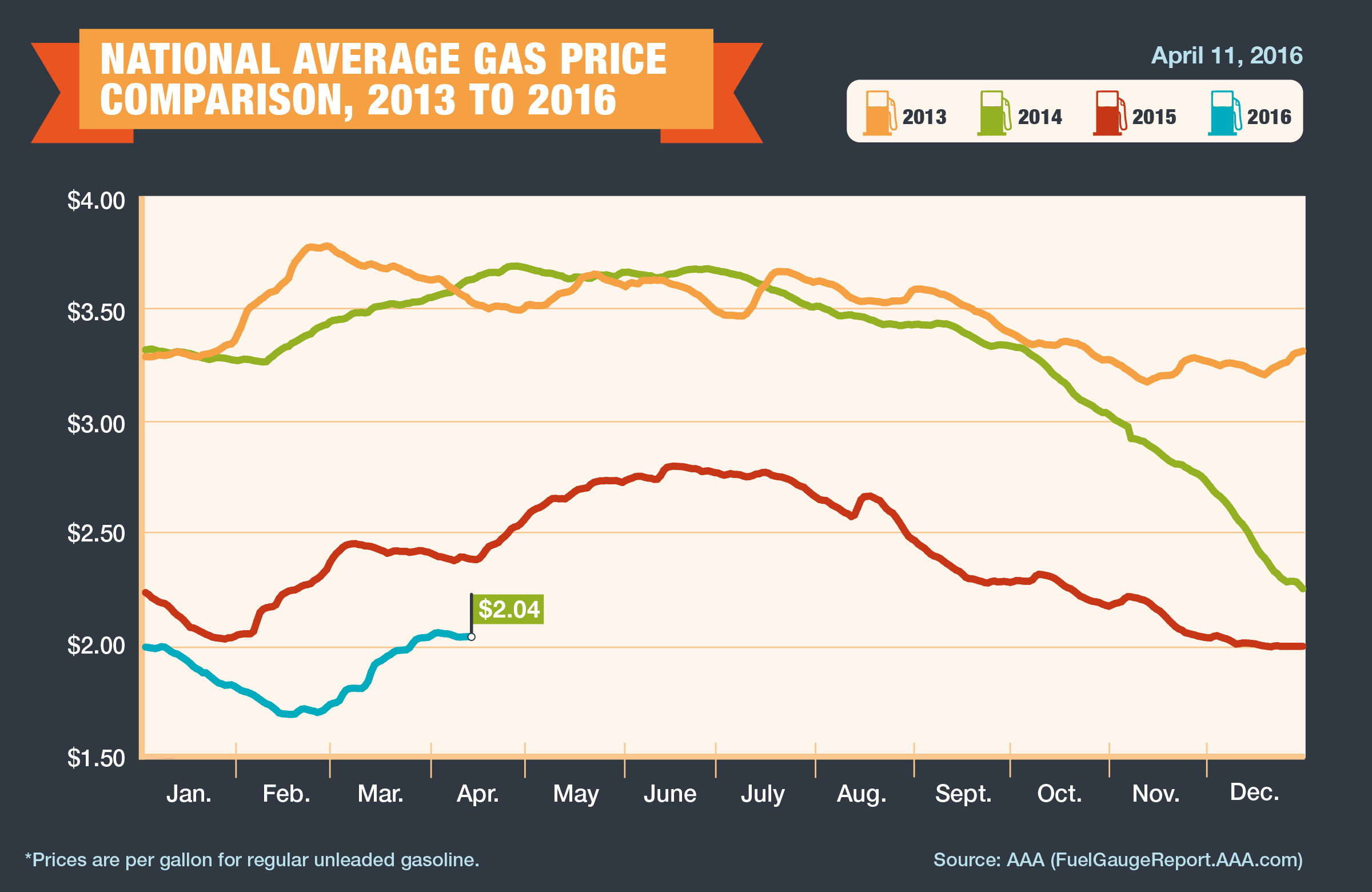(WASHINGTON) The national average price of gas declined on the week for the first time in nearly two months, though the drop was only about one cent. Gas prices have moved higher for 28 of the past 35 days, and motorists are paying 13 cents more per gallon on the month. Today’s average of $2.04 per gallon is the lowest for this day since 2009 and average prices are about 35 cents per gallon cheaper than a year ago.
The national average has spent 19 consecutive days above $2 per gallon, and pump prices are likely to fluctuate as the supply of summer-blend gasoline continues to make its way to terminals nationwide. Refineries are increasing their utilization rates, following the spring maintenance season, and as a result the U.S. EIA reported an increase in domestic gasoline inventories. Just in time for the beginning of the summer driving season, additional supply is also expected to enter the market following the restart of ExxonMobil’s Torrance, Calif. refinery and the gasoline market is poised to be well supplied as we enter the busy summer driving season. Barring any major disruptions or shortages in supply, the above factors may keep pump prices relatively steady in the coming weeks.
California ($2.77) and Hawaii ($2.61) are the only two states with averages above the $2.50 per gallon benchmark. Motorists in the neighboring states of Nevada ($2.44), Washington ($2.29), and Alaska ($2.27) are paying some of the nations’s highest prices at the pump and round out the top five most expensive markets for retail gasoline. On the other end of the spectrum, retail averages in a total of 21 states are below $2 per gallon and consumers in Missouri ($1.80) and Oklahoma ($1.82) are paying nation’s lowest prices for gas.
Gas prices have remained relatively steady on the week, moving by +/- 3 cents per gallon in 45 states and Washington, D.C. Pump prices in the majority of states (32) are down week-over-week, with the largest savings seen by drivers in Michigan (-8 cents) and Missouri (-6 cents). Prices have moved higher on the week in 18 states and Washington, D.C., and motorists in Utah (+10 cents) and Indiana (+5 cents) are paying the largest weekly increases in the price at the pump.
Drivers in the vast majority of states (48) are paying more to refuel their vehicles month-over-month. Retail averages are up double-digits in 29 states and Washington, D.C. over this same period with the biggest jumps in Arizona (+44 cents), Nevada (+28 cents) and Utah (+27 cents). Minnesota (-7 cents) and Missouri (-5 cents) are the only two states to buck this trend, and averages are down in both of these states on the month by a nickel or more per gallon.
Despite pump prices remaining above $2 per gallon, yearly discounts persist for consumers in every state and Washington, D.C. Gas prices in the vast majority of states (48) are down by more than quarter per gallon, with drivers in Alaska (-67 cents), Oregon (-52 cents) and Hawaii (-49 cents) benefitting from the largest year-over-year savings in the price of retail gasoline.
Unclear expectations about future supply and demand continue to influence global oil prices. OPEC is meeting to discuss production issues on April 17, though most market watchers question if the countries will agree on a freeze or whether it will even be effective. A potential freeze in production could cause prices to increase temporarily, though it is difficult to see how it will reduce the market’s extreme oversupply.
The latest data from the U.S. EIA points to a drop in domestic production, which reportedly fell to its lowest point since October 2014. Additionally, domestic crude oil inventories experienced their largest weekly decrease since January, attributed to increases in the refinery utilization rate and the shutdown of the Keystone pipeline due to a leak, which reduced crude oil supply. Both factors are believed to have caused WTI to rally to close out the week.
At the close of Friday’s formal trading session on the NYMEX, WTI was up $2.46 and settled at $39.72 per barrel. This represents one of the strongest settlements for 2016 and is the highest weekly gain since early March.
Motorists can find current gas prices along their route with the free AAA Mobile app for iPhone, iPad and Android. The app can also be used to map a route, find discounts, book a hotel and access AAA roadside assistance. Learn more at AAA.com/mobile.



